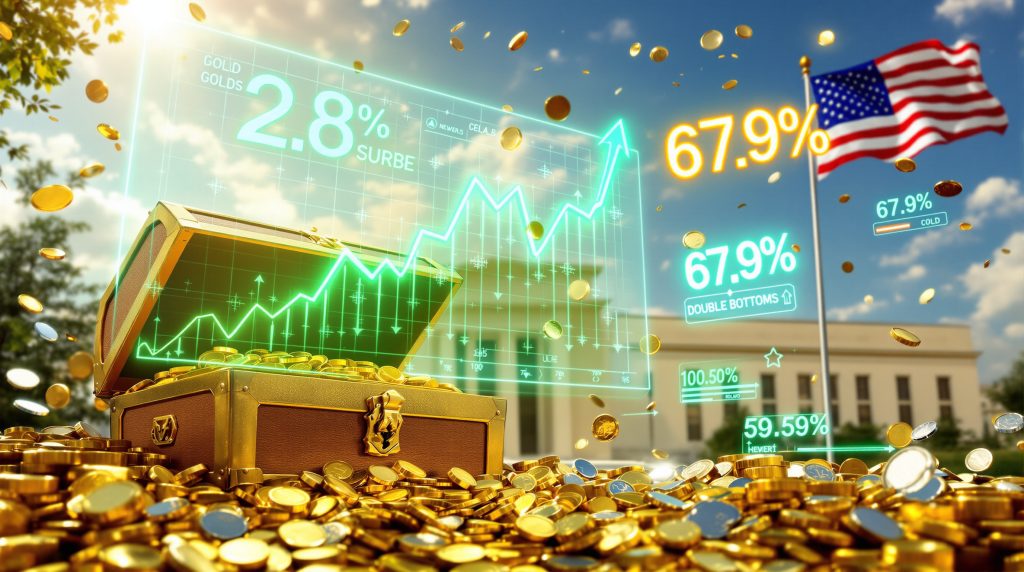The gold price rebound analysis reveals sophisticated technical patterns that experienced traders use to identify optimal entry points during market corrections. Understanding these signals becomes crucial when navigating the volatile precious metals landscape, where timing can significantly impact investment returns. Furthermore, our all-time high analysis provides deeper insights into current market dynamics.
How Technical Indicators Signal Precious Metal Recovery Patterns
Williams %R readings below -80 during confirmed uptrends create compelling contrarian signals for disciplined investors. This momentum oscillator, when combined with 200-day moving average slope analysis, provides a robust framework for identifying temporary weakness within stronger trends.
The methodology requires patience, as oversold conditions can persist longer than anticipated before resolution occurs. Professional traders emphasise waiting for intraday chart pattern resolution rather than immediately buying extreme readings.
Oversold Conditions as Strategic Entry Opportunities
Volume analysis during pullback phases versus recovery phases offers additional confirmation of trend continuation. Heavy selling volume during corrections often capitulates into lighter volume as weakness exhausts itself, followed by increased participation on recovery days.
This pattern emerged clearly during November 2025, when precious metals complex demonstrated textbook oversold rebound characteristics. However, our price surge insights reveal additional factors contributing to the recovery.
The two-hour timeframe proves particularly effective for precious metals, as it captures meaningful price action while filtering out excessive market noise. This approach reduces the risk of catching falling knives during extended oversold periods.
Chart Pattern Recognition for Strategic Positioning
Double-bottom formations on intraday timeframes provide high-probability reversal signals when properly confirmed. The pattern requires two distinct lows at approximately equal levels, connected by a neckline resistance that must be decisively breached to validate the setup.
Volume expansion on the neckline break confirms institutional participation beyond retail speculation. Inverse head-and-shoulders patterns frequently develop in precious metals during correction phases, offering structured entry frameworks for patient investors.
Chart pattern recognition becomes particularly valuable when multiple timeframes align. Weekly charts establish primary trend direction, daily charts identify intermediate patterns, and intraday charts provide precise entry timing.
Economic Catalysts Behind Gold Market Recoveries
Federal Reserve monetary policy expectations drive significant precious metals volatility, with interest rate probability shifts creating immediate price reactions. The interplay between economic data releases, central bank communications, and market positioning generates the fundamental backdrop for technical pattern development.
Federal Reserve Policy Impact Assessment
Interest rate cut probability calculations directly influence precious metals valuations through opportunity cost mechanisms. When Fed Funds Futures pricing indicates 67.9% December rate cut expectations, gold benefits from reduced competition with yielding assets.
This mathematical relationship becomes more pronounced during periods of economic uncertainty. Economic data publication delays during government shutdowns create information vacuums that typically support safe-haven assets.
Market participants, lacking fresh employment, inflation, and consumer spending metrics, often position defensively until clarity emerges. The Federal Reserve's dual mandate creates policy complexity that precious metals investors must navigate carefully.
Government shutdown resolution effects on precious metals prove historically temporary but can provide short-term trading opportunities. The resumption of economic data flows allows Federal Open Market Committee members to make informed decisions, potentially reducing uncertainty premiums embedded in gold prices.
Currency Strength Dynamics During Recovery Phases
USD Index resistance at the psychologically significant 100 level creates critical technical junctures for dollar-denominated commodities. This level previously functioned as strong support throughout 2023-2024, with multiple rallies originating from these prices.
The breakdown below 100 in spring 2025 marked a significant trend change requiring careful monitoring. Inverse correlation patterns between the dollar and precious metals become amplified during policy uncertainty periods.
Currency weakness often coincides with economic concerns that simultaneously drive safe-haven demand, creating dual tailwinds for gold and silver prices. Professional portfolio managers carefully track these relationships for hedging purposes.
According to Forex.com's analysis, technical resistance levels continue to play a crucial role in gold price movements.
American Investor Participation Remains Limited Despite Strong Performance
The participation gap between price appreciation and investor holdings reveals the early-stage nature of the current precious metals bull market. This disconnect creates opportunities for informed investors while suggesting substantial room for continued appreciation.
ETF Holdings Analysis Reveals Market Immaturity
GLD holdings increased merely 16% since October 2022, while gold prices surged 155% over the identical period. This 139 percentage-point divergence indicates that American retail investors have largely missed the initial phase of the bull market rally.
Professional analysts view this underrepresentation as evidence supporting continued upward price potential. SLV holdings remained essentially flat despite silver's remarkable 190% price appreciation since late 2022.
This stagnation in American investor participation contrasts sharply with international demand, particularly from central banks and emerging market investors. The disparity suggests significant catch-up potential exists within domestic markets.
Institutional versus retail participation gaps create interesting portfolio allocation considerations for financial advisors. While major institutions like Goldman Sachs, Bank of America, and HSBC project $5,000 gold targets, retail investors continue avoiding the asset class.
Bull Market Cycle Assessment
Early-stage bull market characteristics include strong price performance with minimal mainstream attention, exactly matching current precious metals market conditions. Historical precedent suggests that mature bull markets feature widespread participation, media coverage, and speculative excess.
Furthermore, understanding secular cycles guide helps investors appreciate the longer-term dynamics at play. Wealth allocation patterns in precious metals remain substantially below historical norms for bull market cycles.
Professional portfolio managers typically allocate 5-10% to precious metals during confirmed uptrends, yet current allocation levels suggest most investors maintain minimal or zero exposure to the sector. Market maturity indicators will include increased ETF inflows, mining stock outperformance, and mainstream financial media coverage expansion.
Near-Term Price Trajectory Analysis for Gold Markets
Technical and fundamental analysis converge to support continued precious metals strength, with specific price targets and timeframes emerging from institutional research. Understanding these projections helps investors set realistic expectations while preparing for potential volatility.
Short-Term Consolidation Range Expectations
The $4,400 resistance level represents the mid-October high that gold approaches during momentum surges. This technical barrier likely requires multiple tests before sustainable breakouts occur, creating trading range opportunities for active investors.
The $4,000 support level appears established as the new floor following the recent correction. Sideways consolidation between these levels allows precious metals to build energy for subsequent upward moves while reducing volatility metrics.
Professional traders utilise range-bound markets for position accumulation and profit-taking strategies. The defined boundaries create structured risk management frameworks while maintaining exposure to potential upside breakouts toward higher targets.
Long-Term Target Validation Framework
The $5,000 institutional consensus target from Goldman Sachs, Bank of America, HSBC, and Société Générale reflects mathematical models incorporating inflation expectations, currency debasement concerns, and geopolitical risk premiums. These projections typically assume 12-24 month timeframes for achievement.
JPMorgan leadership projections extending to $10,000 represent extreme scenarios involving significant monetary system disruption or inflation acceleration beyond current expectations. While these outcomes remain possible, they require substantial fundamental deterioration beyond base case economic assumptions.
The 2026 timeline for $5,000+ gold aligns with Federal Reserve policy normalisation cycles and potential currency system adjustments. This timeframe allows sufficient development of supporting factors while maintaining realistic expectations for market participants.
Additionally, our comprehensive market forecast insights explore the various factors that could influence these projections.
Silver's Recovery Dynamics Compared to Gold Performance
Silver's amplified volatility characteristics create both enhanced opportunities and increased risks compared to gold investments. The industrial demand component adds complexity to precious metals analysis while potentially supporting stronger upward moves during economic recovery periods.
Silver-Specific Technical Pattern Development
The $50 psychological barrier breakthrough carries significant technical implications for silver's long-term trajectory. This level previously acted as resistance during multiple rally attempts, and its violation suggests renewed institutional interest in the white metal.
Gold-silver ratio dynamics during recovery phases typically favour silver outperformance, as evidenced by the 4.5% single-day gain versus gold's 2.8% appreciation. This 160 basis point differential reflects silver's inherent leverage characteristics and lower absolute price levels.
Industrial demand versus monetary demand balance creates unique supply-demand dynamics for silver investments. Economic recovery scenarios potentially support both components simultaneously, while recession fears might favour monetary demand over industrial consumption requirements.
For specific strategies regarding silver investments, our silver price strategies provide detailed guidance for navigating this volatile market.
Volatility Profiles and Risk Assessment
Silver's enhanced volatility creates superior return potential during favourable market conditions while increasing downside risk during corrections. Professional portfolio managers often adjust position sizes to account for these characteristics while maintaining overall precious metals exposure targets.
Historical volatility patterns during bull markets show silver typically outperforming gold by 150-200% over complete cycles. Current performance metrics suggest this relationship remains intact, with silver's 190% gain since October 2022 exceeding gold's 155% appreciation.
Risk-adjusted return considerations favour diversified precious metals exposure rather than concentration in single metals. The correlation benefits of holding both gold and silver provide portfolio stability while capturing the unique characteristics of each asset.
Currency Weakness Implications for Precious Metal Markets
Dollar strength or weakness creates the primary fundamental backdrop for precious metals pricing, with technical analysis of currency markets providing leading indicators for gold and silver direction. Understanding these relationships enhances investment timing and portfolio construction decisions.
Dollar Index Technical Structure Analysis
The 100 resistance level's significance stems from its historical role as major support throughout 2023-2024 market cycles. Multiple rallies originated from this technical level, establishing it as a critical inflection point for currency traders and precious metals investors alike.
Weekly chart patterns indicate potential trend changes when major support levels transform into resistance barriers. The spring 2025 breakdown below 100 created the technical foundation for the current bearish dollar thesis, supported by momentum indicators and volume analysis.
Retest scenarios of former support-turned-resistance frequently result in continuation moves lower, providing the currency backdrop that typically supports precious metals appreciation. Professional currency traders watch these technical developments closely for portfolio positioning guidance.
International Monetary Policy Considerations
Global central bank policy divergence creates cross-currency opportunities that influence precious metals demand from international investors. When Federal Reserve policy becomes more accommodative relative to other major central banks, dollar weakness often results in precious metals strength.
Safe-haven currency competition between the dollar, Swiss franc, and yen affects gold's relative attractiveness during crisis periods. Diversified international investors often substitute between these assets based on relative value assessments and geopolitical developments.
Currency overvaluation indicators suggest the dollar's recent strength may prove unsustainable without corresponding economic outperformance. Technical analysis supports this fundamental assessment, creating confluence for precious metals investment strategies.
According to Investing.com's latest report, government reopening and rate cut expectations continue to influence precious metals markets significantly.
Strategic Positioning for Continued Precious Metal Strength
Investment strategy development requires balancing technical timing signals with fundamental long-term drivers while managing the inherent volatility of precious metals markets. Professional approaches emphasise discipline over emotion during both correction and advancement phases.
Accumulation Strategies During Market Volatility
Dollar-cost averaging during oversold conditions provides systematic exposure building while reducing timing risk associated with volatile markets. The methodology requires predetermined rules for identifying oversold levels and maintaining discipline during periods of maximum pessimism.
Entry point optimisation using intraday charts allows precision timing while maintaining exposure to longer-term trends. The two-hour timeframe proves particularly effective for precious metals, capturing meaningful price action while filtering excessive noise.
Risk management during consolidation phases involves position sizing appropriate to volatility levels while maintaining sufficient exposure to benefit from potential breakouts. Professional traders often use options strategies to enhance returns while limiting downside participation during range-bound markets.
Portfolio Construction Considerations
Physical versus ETF exposure decisions depend on investment objectives, storage capabilities, and liquidity requirements. Physical metals provide ultimate security but lack trading flexibility, while ETFs offer convenience at the cost of counterparty risk and potential tracking errors.
Mining stock correlation analysis reveals varying relationships to underlying metal prices based on operational efficiency, geographic exposure, and financial leverage. Diversified exposure across the precious metals complex often provides superior risk-adjusted returns compared to concentration strategies.
Geographic diversification in precious metals investments helps mitigate regulatory risk while capturing regional demand variations. International exposure through various instruments provides portfolio resilience against domestic policy changes or taxation modifications.
Historical Context Supporting Current Market Analysis
Bull market comparisons provide valuable frameworks for understanding current precious metals dynamics while setting realistic expectations for future performance. Historical precedent offers guidance for both opportunity identification and risk management during various cycle phases.
Previous Cycle Analysis and Patterns
Correction depths within confirmed uptrends typically range from 10-20% before technical support emerges and buying interest returns. The recent precious metals pullback remained within these historical parameters, supporting the temporary correction thesis rather than trend reversal concerns.
Recovery timeframes from oversold conditions average 2-4 weeks in bull market environments, with momentum characteristics providing early signals of reversal completion. Volume expansion and breadth improvement typically accompany sustainable recoveries from correction lows.
Institutional adoption phases during historical cycles show predictable patterns of initial scepticism followed by gradual acceptance and eventual widespread participation. Current precious metals markets appear in early adoption phases based on participation metrics and mainstream sentiment indicators.
Market Development Cycle Expectations
Consolidation period duration estimates suggest 3-6 month sideways trading ranges following significant advances, allowing markets to digest gains while building energy for subsequent moves. These base-building phases often frustrate investors but create foundations for sustainable breakouts.
Energy accumulation during consolidation phases manifests through improving technical indicators, expanding trading ranges, and increased institutional interest. Professional managers often use these periods for position building before mainstream recognition develops.
Market sentiment stabilisation indicators include reduced volatility, narrowing bid-ask spreads, and decreased correlation with risk assets. These factors suggest market maturity development while maintaining upward trajectory potential for informed investors.
Consequently, the gold price rebound analysis demonstrates classic early-stage bull market characteristics, with strong price performance accompanied by limited mainstream participation. Technical indicators support continued strength following the completion of normal correction patterns, while fundamental factors including Federal Reserve policy, currency dynamics, and institutional targeting provide multiple catalysts for sustained appreciation toward $5,000+ objectives over the next 12-24 months.
"Market positioning for 2025-2026 suggests gold's consolidation between $4,000-$4,400 creates accumulation opportunities before the anticipated advance toward institutional targets above $5,000. The combination of technical pattern completion, Federal Reserve policy accommodation, and currency weakness provides multiple catalysts supporting continued precious metals strength."
Looking to Capitalise on the Next Major Gold Discovery?
Discovery Alert's proprietary Discovery IQ model delivers real-time alerts on significant ASX mineral discoveries, instantly empowering subscribers to identify actionable opportunities ahead of the broader market. Understand why major mineral discoveries can lead to exceptional returns by exploring historic examples, then begin your 30-day free trial today to position yourself ahead of the market.




